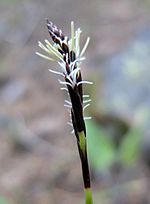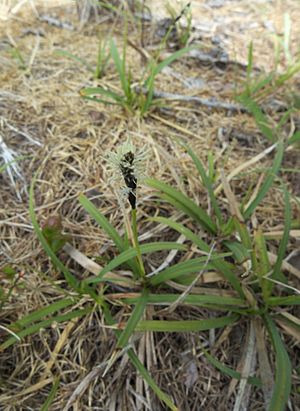Northwestern sedge facts for kids
Quick facts for kids Carex concinnoides |
|
|---|---|
 |
|
| Carex concinnoides near Mission Ridge, Chelan County Washington | |
| Scientific classification | |
| Kingdom: | |
| (unranked): | |
| (unranked): | |
| (unranked): | |
| Order: | |
| Family: | |
| Genus: | |
| Species: |
C. concinnoides
|
| Binomial name | |
| Carex concinnoides Mack.
|
|
Carex concinnoides is a type of plant known as a sedge. Its common name is northwestern sedge because it grows in western North America. You can find this plant from British Columbia in Canada all the way down to California in the United States. It often grows in moist or dry places, especially in forests and on wooded slopes. It prefers soils that are silty or made of clay.
What is Carex concinnoides?
This sedge grows in loose clumps of stems. These stems can reach about 35 centimeters (about 14 inches) tall. The plant spreads using long underground stems called rhizomes. Rhizomes help the plant grow new shoots and spread across an area.
How Does it Look?
The leaves of Carex concinnoides are thick but narrow. They are shaped like a sickle and have a pale green color. The plant's flowers grow in groups called inflorescences. These flower clusters appear at the very top of the stems. Some flower clusters also grow from different points along the stem.
Flowers and Seeds
The small flowers of this sedge have purplish leaf-like parts called bracts. The female flowers, known as pistillate flowers, have a special feature: each one has four stigmas on its pistil. This is a key way to identify this specific sedge. After the flowers are pollinated, they produce fruit. Each fruit is covered in a sac called a perigynium. This sac is usually white to light brown, with a purple tip, and it's covered in tiny hairs.
See also
 In Spanish: Carex concinnoides para niños
In Spanish: Carex concinnoides para niños


